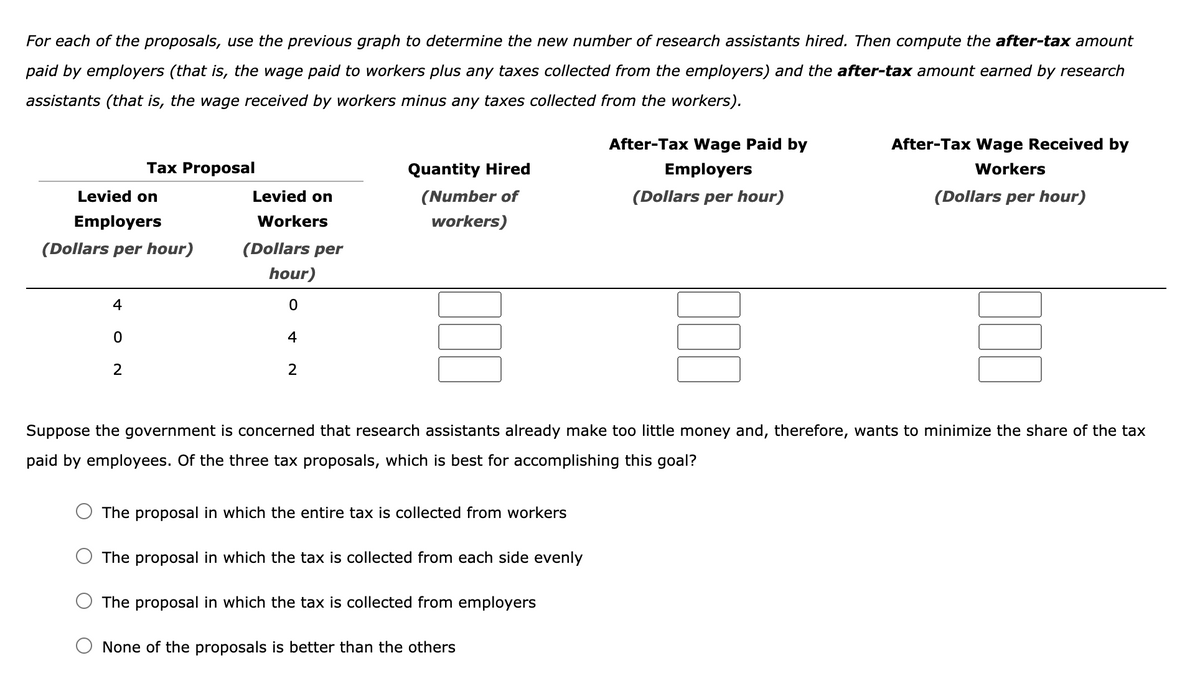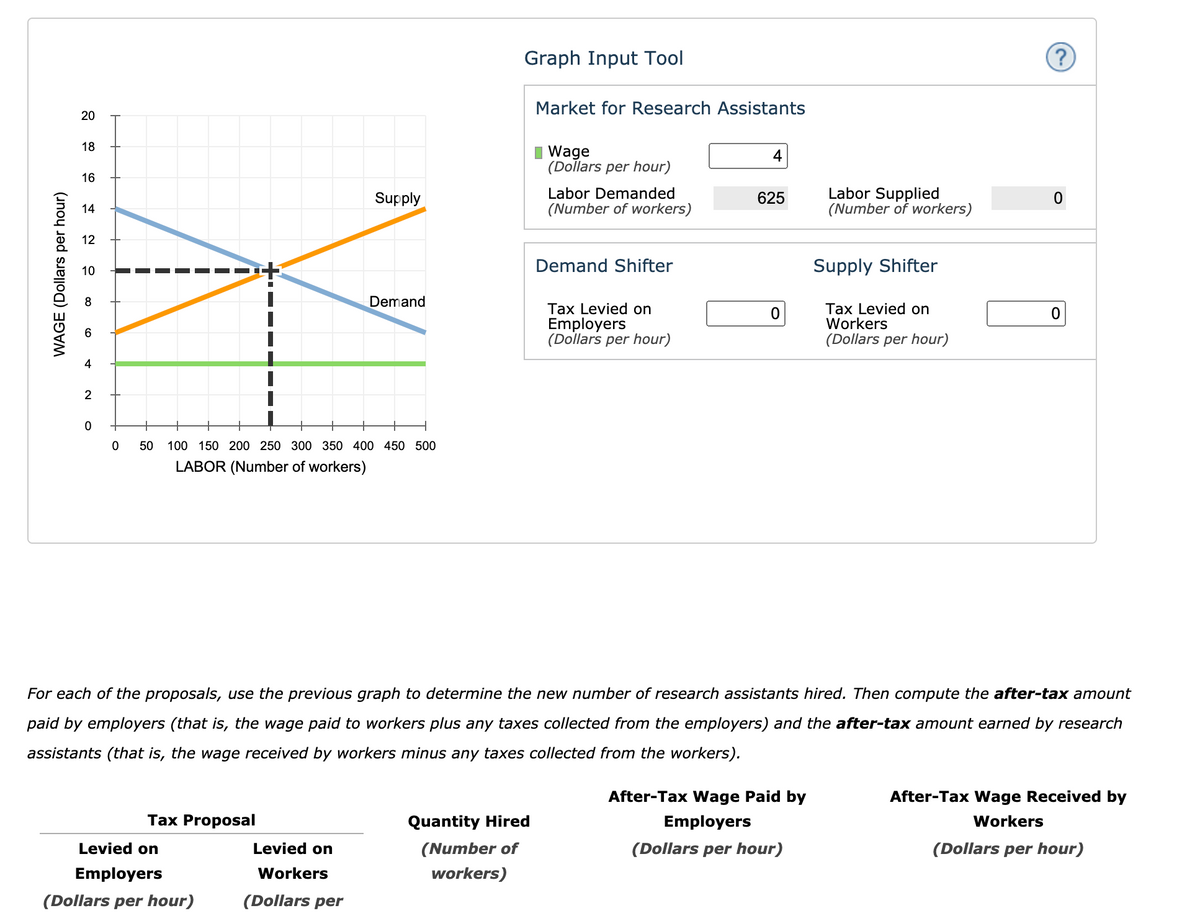For each of the proposals, use the previous graph to determine the new number of research assistants hired. Then compute the after-tax amount paid by employers (that is, the wage paid to workers plus any taxes collected from the employers) and the after-tax amount earned by research assistants (that is, the wage received by workers minus any taxes collected from the workers). After-Tax Wage Paid by After-Tax Wage Received by Tax Proposal Quantity Hired Employers Workers Levied on Levied on (Number of (Dollars per hour) (Dollars per hour) Employers Workers workers) (Dollars per hour) (Dollars per hour) 4 4 Suppose the government is concerned that research assistants already make too little money and, therefore, wants to minimize the share of the tax paid by employees. Of the three tax proposals, which is best for accomplishing this goal? O The proposal in which the entire tax is collected from workers The proposal in which the tax is collected from each side evenly O The proposal in which the tax is collected from employers O None of the proposals is better than the others
For each of the proposals, use the previous graph to determine the new number of research assistants hired. Then compute the after-tax amount paid by employers (that is, the wage paid to workers plus any taxes collected from the employers) and the after-tax amount earned by research assistants (that is, the wage received by workers minus any taxes collected from the workers). After-Tax Wage Paid by After-Tax Wage Received by Tax Proposal Quantity Hired Employers Workers Levied on Levied on (Number of (Dollars per hour) (Dollars per hour) Employers Workers workers) (Dollars per hour) (Dollars per hour) 4 4 Suppose the government is concerned that research assistants already make too little money and, therefore, wants to minimize the share of the tax paid by employees. Of the three tax proposals, which is best for accomplishing this goal? O The proposal in which the entire tax is collected from workers The proposal in which the tax is collected from each side evenly O The proposal in which the tax is collected from employers O None of the proposals is better than the others
Chapter1: Making Economics Decisions
Section: Chapter Questions
Problem 1QTC
Related questions
Question
6. Who should pay the tax?
The following graph shows the labor market for research assistants in the fictional country of Academia. The equilibrium wage is $10 per hour, and the equilibrium number of research assistants is 250.
Suppose the government has decided to institute a $4-per-hour payroll tax on research assistants and is trying to determine whether the tax should be levied on the employer, the workers, or both (such that half the tax is collected from each side).

Transcribed Image Text:For each of the proposals, use the previous graph to determine the new number of research assistants hired. Then compute the after-tax amount
paid by employers (that is, the wage paid to workers plus any taxes collected from the employers) and the after-tax amount earned by research
assistants (that is, the wage received by workers minus any taxes collected from the workers).
After-Tax Wage Paid by
After-Tax Wage Received by
Таx Proposal
Quantity Hired
Employers
Workers
Levied on
Levied on
(Number of
(Dollars per hour)
(Dollars per hour)
Employers
Workers
workers)
(Dollars per hour)
(Dollars per
hour)
4
4
2
Suppose the government is concerned that research assistants already make too little money and, therefore, wants to minimize the share of the tax
paid by employees. Of the three tax proposals, which is best for accomplishing this goal?
The proposal in which the entire tax is collected from workers
The proposal in which the tax is collected from each side evenly
The proposal in which the tax is collected from employers
None of the proposals is better than the others

Transcribed Image Text:Graph Input Tool
Market for Research Assistants
20
18
I Wage
(Dollars per hour)
4
16
Labor Supplied
(Number of workers)
Supply
Labor Demanded
625
14
(Number of workers)
12
Demand Shifter
Supply Shifter
10
8
Demand
Tax Levied on
Workers
(Dollars per hour)
Tax Levied on
Employers
(Dollars per hour)
4
2
50
100 150 200 250 300 350 400 450 500
LABOR (Number of workers)
For each of the proposals, use the previous graph to determine the new number of research assistants hired. Then compute the after-tax amount
paid by employers (that is, the wage paid to workers plus any taxes collected from the employers) and the after-tax amount earned by research
assistants (that is, the wage received by workers minus any taxes collected from the workers).
After-Tax Wage Paid by
After-Tax Wage Received by
Tax Proposal
Quantity Hired
Employers
Workers
Levied on
Levied on
(Number of
(Dollars per hour)
(Dollars per hour)
Employers
Workers
workers)
(Dollars per hour)
(Dollars per
WAGE (Dollars per hour)
Expert Solution
This question has been solved!
Explore an expertly crafted, step-by-step solution for a thorough understanding of key concepts.
This is a popular solution!
Trending now
This is a popular solution!
Step by step
Solved in 3 steps with 3 images

Knowledge Booster
Learn more about
Need a deep-dive on the concept behind this application? Look no further. Learn more about this topic, economics and related others by exploring similar questions and additional content below.Recommended textbooks for you


Principles of Economics (12th Edition)
Economics
ISBN:
9780134078779
Author:
Karl E. Case, Ray C. Fair, Sharon E. Oster
Publisher:
PEARSON

Engineering Economy (17th Edition)
Economics
ISBN:
9780134870069
Author:
William G. Sullivan, Elin M. Wicks, C. Patrick Koelling
Publisher:
PEARSON


Principles of Economics (12th Edition)
Economics
ISBN:
9780134078779
Author:
Karl E. Case, Ray C. Fair, Sharon E. Oster
Publisher:
PEARSON

Engineering Economy (17th Edition)
Economics
ISBN:
9780134870069
Author:
William G. Sullivan, Elin M. Wicks, C. Patrick Koelling
Publisher:
PEARSON

Principles of Economics (MindTap Course List)
Economics
ISBN:
9781305585126
Author:
N. Gregory Mankiw
Publisher:
Cengage Learning

Managerial Economics: A Problem Solving Approach
Economics
ISBN:
9781337106665
Author:
Luke M. Froeb, Brian T. McCann, Michael R. Ward, Mike Shor
Publisher:
Cengage Learning

Managerial Economics & Business Strategy (Mcgraw-…
Economics
ISBN:
9781259290619
Author:
Michael Baye, Jeff Prince
Publisher:
McGraw-Hill Education